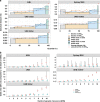Risk prediction of late-onset Alzheimer's disease implies an oligogenic architecture
- PMID: 32968074
- PMCID: PMC7511365
- DOI: 10.1038/s41467-020-18534-1
Risk prediction of late-onset Alzheimer's disease implies an oligogenic architecture
Abstract
Genetic association studies have identified 44 common genome-wide significant risk loci for late-onset Alzheimer's disease (LOAD). However, LOAD genetic architecture and prediction are unclear. Here we estimate the optimal P-threshold (Poptimal) of a genetic risk score (GRS) for prediction of LOAD in three independent datasets comprising 676 cases and 35,675 family history proxy cases. We show that the discriminative ability of GRS in LOAD prediction is maximised when selecting a small number of SNPs. Both simulation results and direct estimation indicate that the number of causal common SNPs for LOAD may be less than 100, suggesting LOAD is more oligogenic than polygenic. The best GRS explains approximately 75% of SNP-heritability, and individuals in the top decile of GRS have ten-fold increased odds when compared to those in the bottom decile. In addition, 14 variants are identified that contribute to both LOAD risk and age at onset of LOAD.
Conflict of interest statement
The authors declare no competing interests.
Figures




References
Publication types
MeSH terms
Grants and funding
LinkOut - more resources
Full Text Sources
Medical

